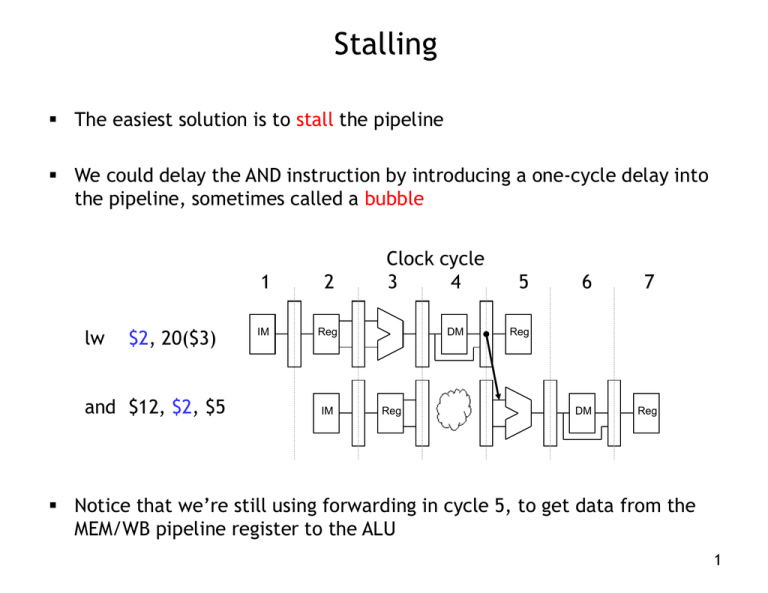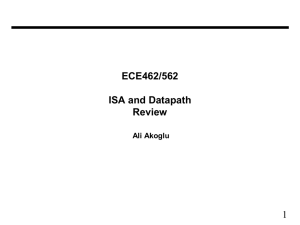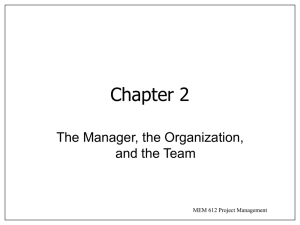stalling
advertisement

Stalling The easiest solution is to stall the pipeline We could delay the AND instruction by introducing a one-cycle delay into the pipeline, sometimes called a bubble lw $2, 20($3) and $12, $2, $5 1 2 IM Reg IM Clock cycle 3 4 DM Reg 5 6 7 DM Reg Reg Notice that we’re still using forwarding in cycle 5, to get data from the MEM/WB pipeline register to the ALU 1 Stalling and forwarding Without forwarding, we’d have to stall for two cycles to wait for the LW instruction’s writeback stage lw $2, 20($3) and $12, $2, $5 1 2 IM Reg IM 3 Clock cycle 4 5 DM 6 7 8 DM Reg Reg Reg In general, you can always stall to avoid hazards—but dependencies are very common in real code, and stalling often can reduce performance by a significant amount 2 Load-Use Hazard Detection • Check when using instruction is decoded in ID stage • ALU operand register numbers in ID stage are given by • IF/ID.RegisterRs, IF/ID.RegisterRt • Load-use hazard when • ID/EX.MemRead and ((ID/EX.RegisterRt = IF/ID.RegisterRs) or (ID/EX.RegisterRt = IF/ID.RegisterRt)) • If detected, stall and insert bubble How to Stall the Pipeline • Force control values in ID/EX register to 0 • EX, MEM and WB do nop (no-operation) • Prevent update of PC and IF/ID register • Using instruction is decoded again • Following instruction is fetched again • 1-cycle stall allows MEM to read data for lw • Can subsequently forward to EX stage Stalling delays the entire pipeline If we delay the second instruction, we’ll have to delay the third one too — This is necessary to make forwarding work between AND and OR — It also prevents problems such as two instructions trying to write to the same register in the same cycle 1 lw $2, 20($3) and $12, $2, $5 or $13, $12, $2 IM 2 3 Reg IM Clock cycle 4 5 DM 7 8 Reg Reg IM 6 DM Reg Reg DM Reg 5 What about EX, MEM, WB But what about the ALU during cycle 4, the data memory in cycle 5, and the register file write in cycle 6? lw $2, 20($3) and $12, $2, $5 or $13, $12, $2 1 2 IM Reg IM 3 Clock cycle 4 5 DM Reg Reg IM IM 6 7 DM Reg 8 Reg Reg DM Reg Those units aren’t used in those cycles because of the stall, so we can set the EX, MEM and WB control signals to all 0s. 6 Detecting Stalls, cont. DM mem\wb Reg Reg ex/mem Reg mem\wb IM DM id/ex and $12, $2, $5 Reg if/id IM id/ex $2, 20($3) if/id lw ex/mem When should stalls be detected? EX stage (of the instruction causing the stall) if/id Reg What is the stall condition? if (ID/EX.MemRead = 1 and (ID/EX.rt = IF/ID.rs or ID/EX.rt = IF/ID.rt)) then stall 7 Adding hazard detection to the CPU PC Write IF/ID Write ID/EX.MemRead Hazard Unit ID/EX Rs Rt 0 0 1 Control PC WB EX/MEM M WB MEM/WB EX M WB IF/ID Read register 1 Addr ID/EX.RegisterRt Instr Read data 1 Read register 2 Write register Instruction memory Write data Read data 2 Registers 0 1 2 ALU Zero ALUSrc 0 1 2 Result 0 Address Data memory 1 Instr [15 - 0] RegDst Extend Rt Write Read data data 1 0 0 Rd 1 Rs EX/MEM.RegisterRd Forwarding Unit MEM/WB.RegisterRd 8 Stalls and Performance Stalls reduce performance — But are required to get correct results Compiler can arrange code to avoid hazards and stalls — Requires knowledge of the pipeline structure Code Scheduling to Avoid Stalls Reorder code to avoid use of load result in the next instruction Ex: c code for A = B + E; C = B + F; stall stall lw lw add sw lw add sw $t1, $t2, $t3, $t3, $t4, $t5, $t5, 0($t0) 4($t0) $t1, $t2 12($t0) 8($t0) $t1, $t4 16($t0) 13 cycles lw lw lw add sw add sw $t1, $t2, $t4, $t3, $t3, $t5, $t5, 0($t0) 4($t0) 8($t0) $t1, $t2 12($t0) $t1, $t4 16($t0) 11 cycles Branches in the original pipelined datapath 1 0 PCSrc Control IF/ID 4 When are they resolved? ID/EX WB EX/MEM M WB MEM/WB EX M WB Add P C Add RegWrite Read Instruction address [31-0] Instruction memory Read register 1 Read data 1 Read register 2 Read data 2 Write register Write data Instr [15 - 0] Instr [20 - 16] Shift left 2 ALU 0 MemWrite Zero Result 1 Registers ALUOp ALUSrc Sign extend Address Data memory Write data RegDst MemToReg Read data 1 MemRead 0 0 Instr [15 - 11] 1 11 Branch Hazards If branch outcome determined in MEM: Flush these instructions (Set control values to 0) PC Reducing Branch Delay Move hardware to determine outcome to ID stage — Target address adder — Register comparator Example: branch taken 36: sub $10, $4, $8 40: beq $1, $3, 7 44: and $12, $2, $5 48: or $13, $2, $6 52: add $14, $4, $2 56: slt $15, $6, $7 ... 72: lw $4, 50($7) Example: Branch Taken Example: Branch Taken Data Hazards for Branches If a comparison register is a destination of 2nd or 3rd preceding ALU instruction add $1, $2, $3 IF add $4, $5, $6 … beq $1, $4, target Can resolve using forwarding ID EX MEM WB IF ID EX MEM WB IF ID EX MEM WB IF ID EX MEM WB Data Hazards for Branches If a comparison register is a destination of preceding ALU instruction or 2nd preceding load instruction Need 1 stall cycle lw $1, addr IF add $4, $5, $6 beq stalled beq $1, $4, target ID EX MEM WB IF ID EX MEM WB IF ID ID EX MEM WB Data Hazards for Branches If a comparison register is a destination of immediately preceding load instruction — Need 2 stall cycles lw $1, addr IF beq stalled beq stalled beq $1, $0, target ID EX IF ID MEM WB ID ID EX MEM WB Branch Prediction • Longer pipelines can’t readily determine branch outcome early • Stall penalty becomes unacceptable • Predict (i.e., guess) outcome of branch • Only stall if prediction is wrong • Simplest prediction strategy • predict branches not taken • Works well for loops if the loop tests are done at the start. • Fetch instruction after branch, with no delay Dynamic Branch Prediction In deeper and superscalar pipelines, branch penalty is more significant Use dynamic prediction Branch prediction buffer (aka branch history table) Indexed by recent branch instruction addresses Stores outcome (taken/not taken) To execute a branch Check table, expect the same outcome Start fetching from fall-through or target If wrong, flush pipeline and flip prediction 1-Bit Predictor: Shortcoming Inner loop branches mispredicted twice! outer: … … inner: … … beq …, …, inner … beq …, …, outer Mispredict as taken on last iteration of inner loop Then mispredict as not taken on first iteration of inner loop next time around 2-Bit Predictor Only change prediction on two successive mispredictions Calculating the Branch Target Even with predictor, still need to calculate the target address 1-cycle penalty for a taken branch Branch target buffer Cache of target addresses Indexed by PC when instruction fetched If hit and instruction is branch predicted taken, can fetch target immediately Concluding Remarks ISA influences design of datapath and control Datapath and control influence design of ISA Pipelining improves instruction throughput using parallelism More instructions completed per second Latency for each instruction not reduced Hazards: structural, data, control Main additions in hardware: forwarding unit hazard detection and stalling branch predictor branch target table











